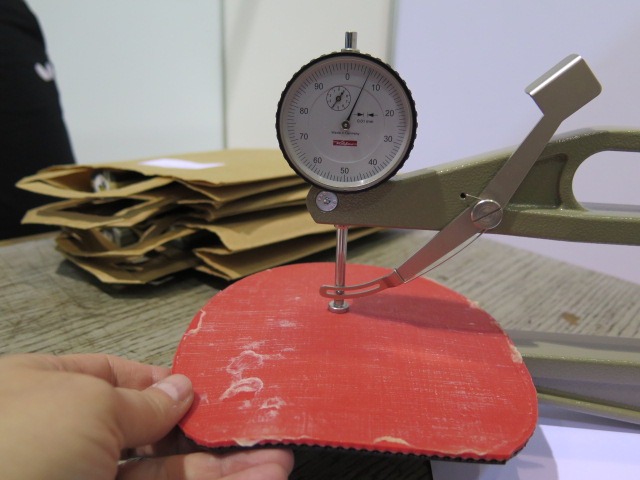Giappone contro la boosterizzazione. Nel 2016 la Federazione giapponese ha proposto all’ITTF un metodo di controllo per combattere la boosterizzazione, basato sull’impiego del gascromatografi, come avevamo già ipotizzato all’inizio del 2015 nel manifesto della campagna “Io gioco pulito”
La proposta giapponese prevede l’uso della cromatografia per misurare qualsiasi tipo di componente oleoso all’interno della gomma. Quindi, solo il prodotto che contiene una componente di olio inferiore al 10% della massa totale della gomma può essere pre-autorizzato.
Dopo che la gomma è stata autorizzata, ITTF eseguirà un test di rimbalzo in determinate condizioni (camera a temperatura controllata) e se la gomma presenta un risultato superiore al limite, la gomma potrebbe non essere autorizzata (in altri sport che usano palle come Tennis, Baseball e Golf esistono test di rimbalzo)
La proposta prevede il controllo della racchetta in tutti gli eventi approvati ITTF (comprese le Olimpiadi) ai giocatori che arrivano in semifinale e finale, o a qualsiasi altro giocatore che è stato scelto dall’arbitro in modo casuale.
Qualunque racchetta che abbia un rimbalzo più alto del livello standard non può essere usata.
La proposta era già stata fatta nel 2013 senza successo
Nel 2015 la Commissione Atleti ITTF ha presentato una proposta sullo spessore della gomma a 4,25 cm (respinta), spiegando che i giocatori “potenziavano” le loro racchette dopo l’acquisto segretamente.
ITTF ha vietato l’uso di booster dopo la fabbricazione delle gomme, ma ha chiuso un occhio sull’introduzione in fase di produzione e ne ha chiuso un altro sul potenziamento dopo l’acquisto.
Secondo i giapponesi, ITTF dovrebbe imporre ai giocatori il rispetto delle regole e l’uso di attrezzature giuste e uguali, una necessità urgente per il bene del nostro sport.
Essendo un membro importante del CIO e per mantenere la fiducia della comunità di atleti di tutto il mondo, questo problema deve essere risolto il prima possibile.
Attrezzatura necessaria: gascromatografo per misurare l’agente che aumenta la repulsione della gomma; strumento per misurare il rimbalzo della gomma; camera climatica per il controllo della temperatura e dell’umidità.
La proposta avrà effetto dal 1/1/2018 e sarà attuata dal 1/1/2019
IL TESTO ORIGINALE
2016 ITTF AGM & BoD Documents, March 2016
Propositions to the Board of Directors Simple majority required. Document G. Proposed by the Japan TTA to include following principles in the Rule paragraphs 3.2.1 – 3.2.4 § PROPOSAL 1: Changing the way in Authorising Sandwich Rubber pimples in (referred as ‘rubber’ hereafter). 1.1.1 To authorise a new rubber, ITTF will use Pyrolysis Chromatograph Analyser to measure any sort of oil component within the rubber. Then, only the product that contains oil component below 10% of the total mass of the rubber may be pre-authorised. 1.1.2 After the rubber has been pre-authorised, ITTF will operate a bounce test under certain conditions (temperature controlled room), and if the rubber shows higher result than the limit, the rubber may not be authorised. NOTE: Other sports using balls such as Tennis, Baseball and Golf have bounce tests with maximum repulsion depending on the material of the equipment. §§ PROPOSAL 2: New Racket Control Procedures 1.2.1 All ITTF approved events (including Olympics) shall apply the new racket control test to the following players. a) Individual Events: All players who has got to Semi-Finals and Finals, or any other player who has been chosen by the referee at random. b) Team Events: The Referee shall choose players from the team that has got to Semi-Finals and Finals, and any other players at random. 1.2.2 The new racket control is to test the rubber of the racket which the player will be using in the next match. The test will be carried out using a bounce test with ITTF authorised equipment. Any racket that has a higher repulsion than standard level may not be used. 1.2.4 If there is any protest to be made against the above 2 sections, the player shall pass his rubber to the ITTF Control Panel. ITTF shall then test the rubber using their Pyrolysis Chromatograph Analyser and compare their result against the result from the same product authorised by the ITTF which has not been in use. ITTF will then conclude, rightfully on this allegation whether boosting was conducted by the player or not. 2. Reason for this Proposal 2.1 At the 2013 ITTF Board Meeting JTTA made a formal proposal to set a limit on repulsion of the rubber so that any boosting that takes place after purchasing the rubber may be eliminated. Then the then President Mr. Sharara announced that this proposal was discussed thoroughly within the Board meeting and this matter still has to be studied. But it was not yet reached to any conclusion. 2.2 At the 2015 AGM ITTF Athletes Commission made a proposal on having the thickness of the rubber to 4.25cm. (this has been rejected.) At the same time it was reported that players have been boosting their rackets after purchase secretly. 2.3 ITTF has banned the use of booster posf-factory, but have been turning a blind eye on boosting at the manufacturing phase, and consecuently ITTF had to turn a blind eye to boosting by the players after purchase. 2.4 ITTF ought to enforce players into respecting the rules and using fair and equal equipment (FAIR PLAY provision), Such is an urgent necessaty of today’s, to the good of our sport. . As being an important member of IOC and to withhold the trust from the world’s athletes community, this problem needs to be resolved as soon as possible. 3. Implementation Setup 3.1 Required Equipment The following equipment’s need to be prepared as ITTF authorised device. 3.1.1 Pyrolysis Gas Chromatograph to measure the Agent increasing repulsion of the rubber. 3.1.2 An appropriate Bounce Test device to measure the maximum repulsion needs to be developed through the past experiment results. 3.1.3 Temperature Humidity Control Cabinet to adjust the test. 3.2 Related Procedures 3.2.1 To avoid the differentiation of repulsion due to different blades, we would need to set a wide range for maximum repulsion. Will need to have a plate (benchmark) to put the rubber on to when measuring. In case there is no Temperature Humidity Control Cabinet, there should be a list made that contains a wide range of results for different types of racket on different temperatures to be used as a measurement. 3.2.2 When a new rubber is subjected from the manufacturers for ITTF approval, they need to supply the rubber sheet with sponge put together. Also the sample rubber/sponge must be the thickest available. 3.2.3 For the ITTF to run this proposed test, ITTF will provide (rent) the equipment Pyrolysis Gas Chromatograph if possible, and Bounce Test device to the host association. 3.2.4 In order to analyse this test, ITTF will prepare a guideline and provide a practice session at WTTC or other events. 3.3 Timing of implementation 3.3.1 This Proposal (1) shall take effect as of January 1st, 2018. 3.3.2 Proposal (2) shall be implemented as of January 1st, 2019








